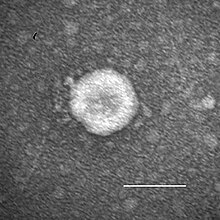
Back فيروس كورونا دلتا Arabic Deltacoronavirus Catalan Deltacoronavirus Spanish دلتاکروناویروس Persian Deltacoronavirus French डेल्टाकोरोनावायरस Hindi Deltakoronavirus Croatian Deltacoronavirus Italian Deltacoronavirus Romanian தெலுத்தா கொரோனா வைரசு Tamil
| Deltacoronavirus | |
|---|---|

| |
| Electron micrograph of coronavirus HKU15. Scale bar indicates 100 nm. | |
| Virus classification | |
| (unranked): | Virus |
| Realm: | Riboviria |
| Kingdom: | Orthornavirae |
| Phylum: | Pisuviricota |
| Class: | Pisoniviricetes |
| Order: | Nidovirales |
| Family: | Coronaviridae |
| Subfamily: | Orthocoronavirinae |
| Genus: | Deltacoronavirus |
| Subgenera and species | |
Deltacoronavirus (Delta-CoV) is one of the four genera (Alpha-, Beta-, Gamma-, and Delta-) of coronaviruses. It is in the subfamily Orthocoronavirinae of the family Coronaviridae. They are enveloped, positive-sense, single-stranded RNA viruses. Deltacoronaviruses infect mostly birds and some mammals.
While the alpha and beta genera are derived from the bat viral gene pool, the gamma and delta genera are derived from the avian and pig viral gene pools.[1]
Recombination appears to be common among deltacoronaviruses.[2] Recombination occurs frequently in the viral genome region that encodes the host receptor binding protein. Recombination between different viral lineages contributes to the emergence of new viruses capable of interspecies transmission and adaptation to new animal hosts.[2]
- ^ Woo PC, Lau SK, Lam CS, Lau CC, Tsang AK, Lau JH, Bai R, Teng JL, Tsang CC, Wang M, Zheng BJ, Chan KH, Yuen KY (2012). "Discovery of seven novel Mammalian and avian coronaviruses in the genus deltacoronavirus supports bat coronaviruses as the gene source of alphacoronavirus and betacoronavirus and avian coronaviruses as the gene source of gammacoronavirus and deltacoronavirus". J. Virol. 86 (7): 3995–4008. doi:10.1128/JVI.06540-11. PMC 3302495. PMID 22278237.
- ^ a b Lau SKP, Wong EYM, Tsang CC, Ahmed SS, Au-Yeung RKH, Yuen KY, Wernery U, Woo PCY. Discovery and Sequence Analysis of Four Deltacoronaviruses from Birds in the Middle East Reveal Interspecies Jumping with Recombination as a Potential Mechanism for Avian-to-Avian and Avian-to-Mammalian Transmission. J Virol. 2018 Jul 17;92(15):e00265-18. doi: 10.1128/JVI.00265-18. Print 2018 Aug 1. PMID 29769348